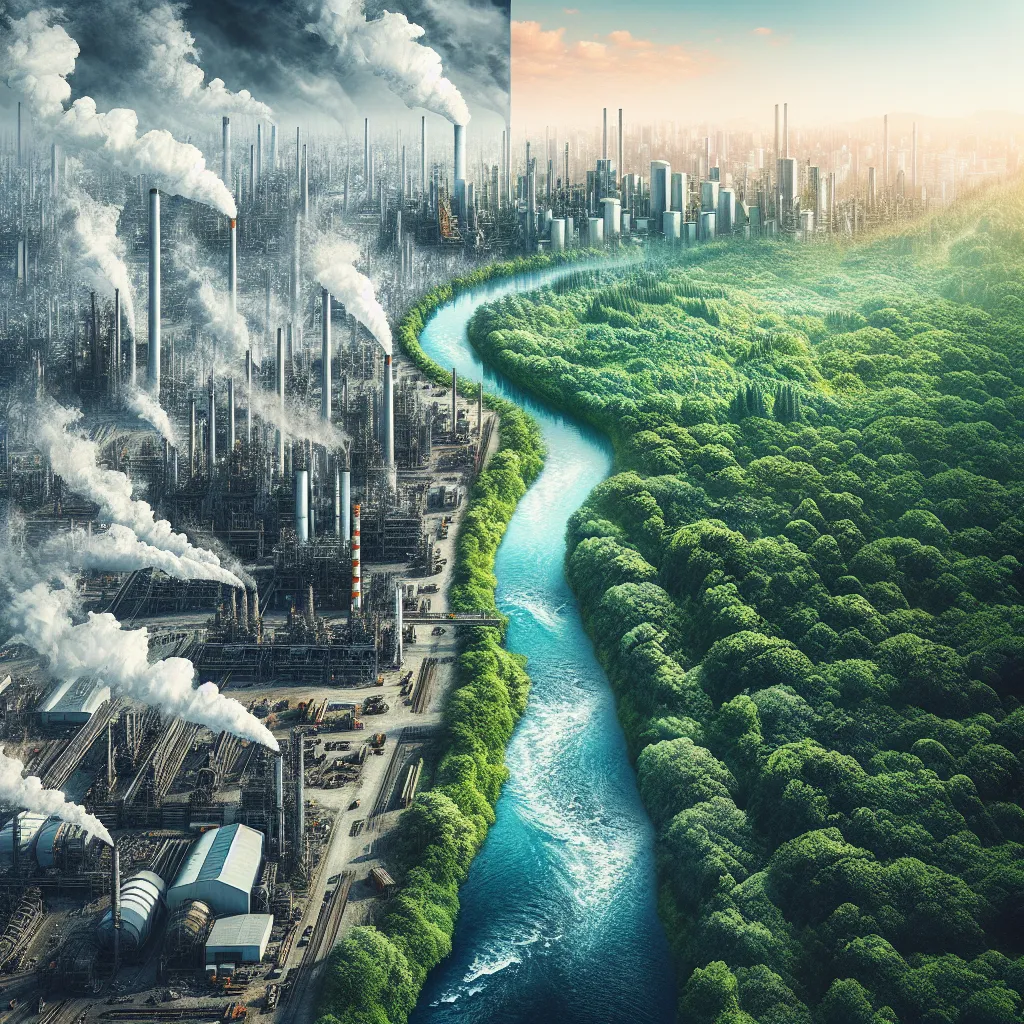The IELTS Reading section is a crucial component of the exam, testing your ability to comprehend complex texts and extract relevant information. Today, we’ll focus on a topic that has frequently appeared in past IELTS exams and remains highly relevant: “The Impact of Industrial Growth on the Environment.” This subject has been a recurring theme in IELTS Reading passages, reflecting its global importance and the ongoing debate surrounding industrial development and environmental conservation.
Given the current global emphasis on sustainable development and climate change mitigation, it’s highly likely that similar topics will continue to appear in future IELTS exams. Let’s dive into a practice passage and questions to help you prepare for this type of content in your upcoming test.
 Industrial growth impact on environment
Industrial growth impact on environment
Practice Reading Passage
The Double-Edged Sword of Industrial Growth
Industrial growth has been a cornerstone of economic development for nations worldwide, propelling societies from agrarian-based economies to technologically advanced powerhouses. However, this progress has come at a significant environmental cost, creating a complex relationship between industrial advancement and ecological preservation.
The rapid expansion of industries since the Industrial Revolution has led to unprecedented economic growth and improved living standards for millions. Manufacturing, energy production, and transportation sectors have flourished, creating jobs and fostering innovation. Countries that have embraced industrialization have seen marked increases in GDP, urbanization, and overall quality of life for their citizens.
Nevertheless, the environmental ramifications of this growth are profound and far-reaching. One of the most pressing concerns is air pollution. The burning of fossil fuels in factories and power plants releases vast quantities of greenhouse gases, particularly carbon dioxide, into the atmosphere. These emissions contribute significantly to global warming and climate change, leading to rising sea levels, more frequent extreme weather events, and disruptions to ecosystems worldwide.
Water pollution is another critical issue stemming from industrial activities. Many industries discharge untreated or poorly treated wastewater into rivers, lakes, and oceans, contaminating water sources with harmful chemicals, heavy metals, and organic pollutants. This not only threatens aquatic life but also poses risks to human health when polluted water is used for drinking, irrigation, or recreation.
Deforestation, often driven by the need for raw materials or land for industrial expansion, further exacerbates environmental degradation. Forests act as crucial carbon sinks and habitats for countless species. Their destruction not only releases stored carbon into the atmosphere but also leads to biodiversity loss and soil erosion.
The generation of solid waste, including hazardous materials, is yet another environmental challenge posed by industrial growth. Improper disposal of industrial waste can lead to soil contamination, affecting agricultural productivity and posing long-term health risks to local communities.
However, it’s important to note that the relationship between industrial growth and environmental impact is not entirely negative. Technological advancements driven by industrial innovation have also paved the way for more sustainable practices. The development of renewable energy technologies, more efficient manufacturing processes, and improved waste management systems are examples of how industry can contribute to environmental solutions.
Many countries are now recognizing the need for sustainable industrial development. Policies promoting cleaner production methods, investment in green technologies, and stricter environmental regulations are being implemented globally. The concept of a circular economy, where resources are used, recovered, and regenerated in a closed loop, is gaining traction as a model for sustainable industrial growth.
International cooperation is also playing a crucial role in addressing the environmental challenges posed by industrialization. Global agreements such as the Paris Climate Accord aim to limit greenhouse gas emissions and promote sustainable development practices across nations.
In conclusion, while industrial growth has been a key driver of economic prosperity, its environmental costs cannot be ignored. The challenge for the future lies in finding a balance between continued industrial development and environmental preservation. This will require innovative solutions, policy reforms, and a collective commitment to sustainable practices from governments, industries, and individuals alike.
Questions
True/False/Not Given
Determine whether the following statements are True, False, or Not Given based on the information in the passage.
- Industrial growth has solely positive effects on national economies.
- Air pollution from industrial activities contributes to global warming.
- Water pollution from industries affects only aquatic life.
- Deforestation for industrial purposes leads to biodiversity loss.
- All countries have strict regulations to control industrial waste disposal.
- Technological advancements in industry can contribute to environmental solutions.
- The concept of a circular economy is universally adopted by all industries.
Multiple Choice
Choose the correct letter, A, B, C, or D.
-
According to the passage, which of the following is NOT mentioned as a consequence of industrial growth?
A) Improved living standards
B) Increased urbanization
C) Higher literacy rates
D) Job creation -
The main environmental concern related to the burning of fossil fuels is:
A) Water pollution
B) Soil erosion
C) Greenhouse gas emissions
D) Noise pollution -
Which of the following best describes the passage’s view on the relationship between industrial growth and the environment?
A) Entirely negative
B) Mostly positive with some drawbacks
C) Complex with both positive and negative aspects
D) Neutral with no significant impact
Matching Headings
Match the following headings to the correct paragraphs in the passage. Write the correct number (i-viii) next to the paragraph number (11-14).
i. The Role of International Cooperation
ii. Economic Benefits of Industrialization
iii. Air Pollution: A Major Concern
iv. Balancing Growth and Conservation
v. Water Contamination from Industrial Activities
vi. Deforestation and Its Consequences
vii. Waste Management Challenges
viii. Technological Solutions for Sustainability
- Paragraph 2: _____
- Paragraph 3: _____
- Paragraph 4: _____
- Paragraph 8: _____
Summary Completion
Complete the summary below using words from the box. Write the correct letter (A-L) next to questions 15-20.
A) prosperity B) pollution C) deforestation D) sustainable E) circular F) innovation
G) emissions H) waste I) regulations J) cooperation K) renewable L) efficiency
Industrial growth has been a key driver of economic (15) but has led to significant environmental challenges. These include air and water (16) , (17) , and the generation of hazardous (18) . However, industrial (19) has also contributed to the development of more (20) practices, such as renewable energy technologies and improved waste management systems.
Answer Key and Explanations
True/False/Not Given
- False – The passage mentions both positive and negative effects of industrial growth.
- True – The text states that emissions from burning fossil fuels contribute to global warming.
- False – The passage mentions risks to both aquatic life and human health.
- True – The text directly states that deforestation leads to biodiversity loss.
- Not Given – The passage doesn’t provide information about the strictness of regulations in all countries.
- True – The text mentions technological advancements contributing to environmental solutions.
- Not Given – The passage doesn’t state whether all industries have adopted the circular economy concept.
Multiple Choice
- C – Higher literacy rates are not mentioned in the passage as a consequence of industrial growth.
- C – The passage explicitly states that greenhouse gas emissions from burning fossil fuels contribute to global warming.
- C – The passage presents a balanced view, discussing both positive and negative aspects of industrial growth’s impact on the environment.
Matching Headings
- ii – This paragraph focuses on the economic benefits of industrialization.
- iii – This paragraph primarily discusses air pollution from industrial activities.
- v – This paragraph is about water pollution caused by industrial discharge.
- viii – This paragraph discusses how technological advancements can lead to more sustainable industrial practices.
Summary Completion
- A – prosperity
- B – pollution
- C – deforestation
- H – waste
- F – innovation
- D – sustainable
Common Mistakes to Avoid
- Overlooking negative statements: In True/False/Not Given questions, be cautious with negative statements. They can be tricky and require careful reading.
- Assuming information: For Not Given statements, avoid making assumptions based on general knowledge. Stick strictly to the information provided in the passage.
- Misinterpreting Multiple Choice options: Read all options carefully before selecting an answer. Sometimes, multiple options may seem correct, but only one will be the best fit.
- Rushing through Matching Headings: Take time to understand the main idea of each paragraph before matching it with a heading.
- Using personal knowledge in Summary Completion: Rely solely on the information given in the passage, not on your own knowledge of the topic.
Vocabulary Focus
- Cornerstone: /ˈkɔːnəstəʊn/ (noun) – a fundamental or essential part
- Ramifications: /ˌræmɪfɪˈkeɪʃənz/ (noun) – consequences or implications
- Exacerbate: /ɪɡˈzæsəbeɪt/ (verb) – to make worse or more severe
- Biodiversity: /ˌbaɪəʊdaɪˈvɜːsəti/ (noun) – the variety of plant and animal life in a particular habitat
- Circular economy: /ˈsɜːkjələr iˈkɒnəmi/ (noun) – an economic system aimed at eliminating waste and the continual use of resources
Grammar Spotlight
Pay attention to the use of present perfect tense in the passage, e.g., “Industrial growth has been a cornerstone of economic development.” This tense is used to describe actions or situations that started in the past and continue to have relevance in the present.
Tips for Success
- Practice active reading: Engage with the text by highlighting key points and making mental summaries as you read.
- Improve your vocabulary: Regularly learn new words related to environment and industry to better understand complex texts.
- Time management: Allocate your time wisely between reading the passage and answering questions.
- Skim and scan: Use these techniques to quickly locate specific information when answering questions.
- Stay informed: Keep up with current affairs, especially those related to environment and industry, as they often form the basis of IELTS Reading passages.
Remember, success in IELTS Reading comes with consistent practice and a strategic approach. Focus on understanding the main ideas and supporting details in passages, and always base your answers on the information provided in the text.
For more practice on related topics, check out our articles on the impact of industrialization on social structures and the effects of industrial pollution on health. These will provide additional context and vocabulary that could be useful in your IELTS preparation.


